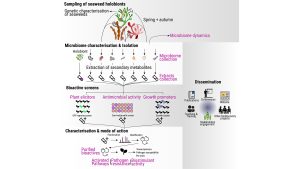Whether mining marine microbiomes for natural crop enhancers or reviving the value of Irish-grown wool through bioeconomy innovations, these interdisciplinary projects are redefining what agricultural resilience and rural regeneration can look like in a climate-challenged world.
Agriculture, a cornerstone of global food production and rural economies, is increasingly under pressure from a combination of environmental stressors and shifting market demands. Climate change, with its unpredictable weather patterns, extreme events, and growing frequency of pests and diseases, poses significant challenges to crop and livestock production.
At the same time, the need for more sustainable practices has never been greater—farming systems must evolve to reduce environmental impact, improve resource efficiency, and foster long-term resilience. As traditional farming methods reach their limits, innovative solutions that integrate nature’s own systems are gaining attention.
From bioactive compounds derived from marine microbes to the untapped potential of waste products like wool, the focus on sustainability is driving research toward more circular, eco-friendly approaches to agriculture. These forward-thinking strategies not only aim to safeguard the planet’s future but also promise new opportunities for rural development and economic growth. To address these pressing challenges, three pioneering research initiatives at TUS are taking significant strides toward more sustainable and resilient agricultural practices.
Land plants are increasingly subjected to environmental pressures due to climate change. Extreme weather events are becoming more frequent, and as a result, crops are constantly threatened by excess rainfall and the emergence of harmful pathogens. To tackle this issue, it is essential to reduce our impact on the climate while also identifying novel solutions to enhance crop yields and resilience. Crucially, these solutions must be eco-friendly to prevent further harm to our ecosystems.
In recent years, the association between seaweeds and the microbial communities that thrive on them has garnered attention. For instance, a number of bacterial and fungal species living in or on seaweeds were found to be in the thousands, creating their own ecosystem in and around seaweeds. So much so that the microbiome and the seaweed it inhabits are now referred to as its own ecological unit – the holobiont! Enter Seaweed-Associated Microbiome (SAM).
A particularly fascinating aspect of the SAM is its ability to produce bioactive compounds. Research has shown that the bacteria living on seaweeds generate antimicrobial substances, prevent the colonisation of harmful bacteria, and even inhibit the formation of biofilms. These bioactive compounds are likely a survival mechanism, as life on seaweed can be incredibly crowded for microbes. Given this, it’s highly plausible that the SAM harbours compounds with potential applications in human health and medicine, especially in combating challenges like antimicrobial resistance. It has been discovered that certain seaweeds, such as sea lettuce, rely on their bacterial communities for growth and development. Remarkably, bacteria within the SAM produce hormones that are similar to those found in crops, which are essential for the seaweed’s proper growth. In addition, the SAM generates compounds that mirror those used by plants to stimulate their immune systems.
This raises an intriguing possibility: could the microbes associated with seaweed produce compounds that enhance crop growth, strengthen plant defences, or even eliminate pathogens? This question led Dr Antoine Fort to create AMicrobioM (Algal Microbiome Mining), a four-year research project funded by Research Ireland as part of their Frontiers for the Future programme.
Algal Microbiome Mining (AMicrobioM)
The aims of the project are multiple. First, further work is to be conducted on the precise composition of the seaweed microbiome to unravel the factors that influence its makeup. Detecting most, if not all, of the bacteria present in a sample is no small task, but the latest advancements in DNA sequencing technologies have made this possible. Small chips with hundreds of tiny pores are now capable of reading the sequence of DNA molecules as they pass through. This technology can be leveraged to detect the bacteria present on the seaweeds by reading their DNA, much like scanning a barcode at the grocery store. Characterising the microbial community living on and in seaweeds is expected to be highly relevant for aquaculture efforts surrounding seaweed farming, providing a better understanding of the role the microbiome plays in seaweed growth, resilience, and reproductive success.
Second and most importantly, a collection of seaweed-associated microbes will be created, with hundreds of bacterial species safely catalogued and stored, ready to be tested for producing valuable compounds. Dr Thomas Wichard’s expertise in microbiome research at Jena University, Germany, will be utilised in this phase.

Additionally, TUS’s extensive knowledge and expertise in microbial culture collections and applied microbiology will be leveraged. This will be no small feat: thousands of microbial species are expected to be present across all samples, and isolating them will not be straightforward. Each species has different needs, including varying food requirements and optimal temperatures for growth, so many different strategies will be employed.
Third, the presence of bioactive compounds produced by the bacteria in the collection will be tested on crops and crop pathogens, leveraging the vast expertise of Professor Emmanuelle Graciet (University of Maynooth) to detect potential new natural molecules that stimulate crop growth and promote crop health. This phase presents challenges: first, the compounds produced by the bacteria must be extracted (as crude extracts, since separating them at this stage would be too time-consuming), and then these extracts will be applied to plants to observe their responses. Although this may seem like a lot of work—and it is—a high-throughput screening system has been designed to test plant responses to the extracts.
One of the screening methods involves genetically engineered plants that turn blue if the extract stimulates their pathogen defence system. This allows for the rapid testing of all extracts for bioactivities, including pathogen defence, plant germination, growth, and antimicrobial activity. Once identified, the compounds will be characterised using state-of-the-art analytical chemistry techniques, in collaboration with Professor Olivier Thomas from the University of Galway, as well as TUS’ own in-house facilities, which include mass spectrometers and compound separation equipment, ranging from high-pressure liquid chromatography to gas chromatography versions. After the precise bioactive compounds are identified, efforts will be made to explore ways to stimulate their production for industrial applications, as well as to understand their mode of action better.
The long-term goal of the project is to utilise these compounds as greener alternatives to agrochemicals by reducing fertiliser inputs without compromising yields and providing natural alternatives to pesticides, thus reducing their use. AMicrobioM is expected to lead to the identification of many new bacterial species and a wide range of novel bioactive compounds, which could profoundly impact crop yields. The planned industrial application of these molecules in agriculture will undoubtedly generate economic interest while contributing to more sustainable crop production and positioning TUS at the forefront of agricultural innovation.
This project is truly multi-disciplinary given its reliance on seaweed biology, microbiology, genetics, chemistry and plant science. It is also highly innovative, as, to our knowledge, the approach of testing the seaweed microbiome for bioactive compounds with terrestrial applications in crops has not yet been explored.
Outside of crop science, once tucked away, the AMicrobioM collection of bacterial isolates and their extracts will also open collaborations for human- and animal health-related research projects within the Faculty of Science and Health at the TUS: Could any of the extracts limit the proliferation of cancer cells? Do they contain novel antimicrobials against antibiotic-resistant bacteria? Are there plastic-degrading bacteria in the collection? Are there bacteria that degrade or inhibit the formation of biofilms? Many research questions could be answered using the AMicrobioM bacterial collection, and we are always open to exploring new collaborations.
For several decades, Irish-grown wool has been trapped in a cycle of declining prices and diminishing quality. Over the past 30 years, the price paid per kilogramme has plummeted to a mere 0.01% of its original value. As a result, Irish wool is often exported at a fraction of its worth, stored in the hope of future price recovery, or discarded entirely. Despite its potential, wool and its by-products remain an undervalued resource, not fully utilised as a value-added product or bioeconomy biomass. The cost of shearing a sheep is approximately €2.50. Yet, farmers receive only about 40 cents for the fleece, creating a financial strain that threatens the sustainability of farming, rural enterprise, and the economic development of rural Ireland. This situation presents a critical missed opportunity to support sheep farmers, foster sustainable development, and unlock valuable enterprise opportunities.
In response, researchers at the Centre for Applied Bioscience Research within the LIFE Institute are leading and partnering in two projects to advance research to restore value to Irish wool and help revitalise the industry. The Centre for Applied Bioscience Research was established in 2007 to develop processes and applications for waste biomass. Since then, the Centre has become a leader in biomass innovation and the bioeconomy with expertise in extraction, identification, characterisation and mode of action testing, providing a platform for the circular bioeconomy. While processing of wool is a relatively new biomass for the Centre, the expertise developed over almost 20 years means that this can be applied to new strategic areas, accelerating innovation and advancing research.
The SPRINGWOOL project
The SPRINGWOOL project seeks to eliminate key bottlenecks and pave the way for innovation in the Irish wool sector. Currently, wool is significantly undervalued in Ireland, with farmers losing money on every sheep they shear. One of the major challenges faced by the industry is the lack of scouring facilities in Ireland, an essential step in the wool cleaning process. This project will address this gap by developing more efficient wastewater treatment methods for scouring, facilitating the establishment of small-scale, on-island facilities.
Led by researchers from TUS, MTU, ATU, and UCD, and funded by the Department of Agriculture, Food and the Marine, SPRINGWOOL brings together multidisciplinary expertise to unlock the untapped potential of Irish-grown wool. Dr Emma Murphy and Dr Yin Zhu are leading key work packages within the project from TUS, focusing on extracting high-value compounds such as ceramides and keratin from wool for testing in cosmetic and medical device applications, in collaboration with teams at MTU.
This marks a significant advancement, as TUS researcher Dr Tielidy Lima has already succeeded in creating wool-based extracts for testing in cosmetic and medical device applications—an achievement believed to be the first of its kind in Ireland.
The project also explores sustainable and creative uses for the residual biomass generated during the extraction process. Researchers at the Limerick School of Art and Design and the Materials Research Institute in TUS will investigate applications in textiles and bioplastics, aiming to transform what is currently considered waste into valuable materials. In parallel, wastewater from the scouring process will be targeted for treatment innovation at TUS, enhancing the environmental sustainability of future wool-processing infrastructure.
Further supporting the circular bioeconomy approach, Dr Peter Downey at TUS will collaborate with ATU on a composting work package, specifically assessing how wool-based compost affects plant growth. Complementing this, SPRINGWOOL will also develop a standardised compost recipe, accompanied by plant growth trials, ensuring that every aspect of the wool lifecycle—from fleece to field—is explored for value and sustainability.
Together, these efforts aim not only to revitalise the Irish wool industry but also to support farmers, create new bio-based value chains, and stimulate rural economic development through science-driven innovation.
The RevEire project
In parallel to SPRINGWOOL, researchers at TUS are also playing a key role in RevEire (Regenerative Value Systems for Irish Grown Wool in Ireland), a new project funded by the Environmental Protection Agency. RevEire, led by Dr Archisman Bose in UCC, seeks to reimagine Irish wool—not as waste, but as a valuable, renewable resource that can contribute meaningfully to a circular and sustainable bioeconomy. The project aims to research how materials, products and value chains for Irish wool can be enhanced as a means of improving Ireland’s sustainability in relation to the European Green Deal and the Circular Economy Action Plan.
As part of the project, Dr Yin Zhu, Dr Catherine Collins and Dr Tim Yeomans at TUS are leading the development of a scouring-driven cascading biorefinery—a novel process that explores more sustainable approaches to wool washing while also valorising the by-products, including wastewater.

This innovative system reflects a broader effort to reduce environmental impact while capturing value from every step of wool processing.
Source link

